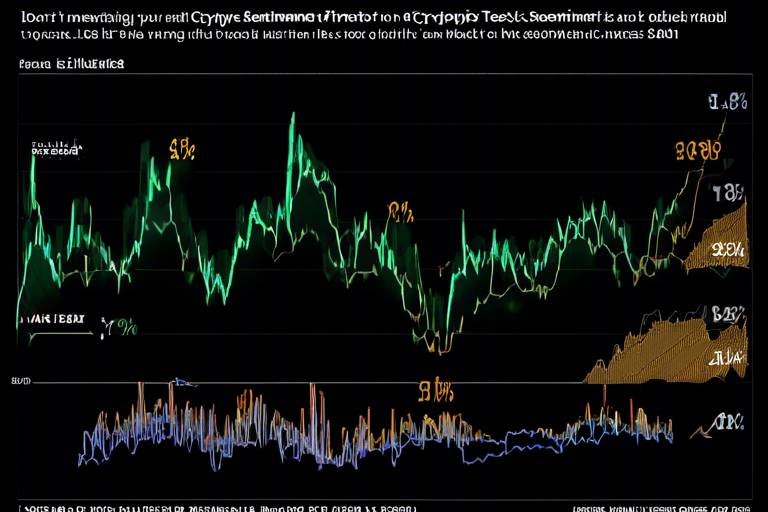How to Use Fundamental Analysis in Crypto Investing
Investing in cryptocurrencies can feel like navigating a maze, with twists and turns at every corner. But don't worry! By using fundamental analysis, you can illuminate the path ahead. Fundamental analysis is all about digging deep into the core of a cryptocurrency to understand its true value. Think of it as examining the roots of a plant before deciding whether to nurture it or let it wither away. In the world of crypto, this means evaluating factors like technology, team expertise, market demand, and economic conditions. By doing so, you can make informed decisions that could lead to profitable investments.
So, why is fundamental analysis so crucial in the crypto market? Well, unlike traditional stocks, cryptocurrencies can be incredibly volatile, with prices swinging wildly based on market sentiment. By focusing on the fundamentals, you can cut through the noise and hype, allowing you to identify projects that have the potential for long-term growth. This article will guide you through the principles of fundamental analysis, key metrics to consider, and effective strategies to evaluate the potential of digital assets.
At its core, fundamental analysis is about understanding a cryptocurrency's intrinsic value. This involves looking beyond the price charts and examining the underlying factors that contribute to a cryptocurrency's worth. It’s like looking under the hood of a car to see how well it runs rather than just admiring its shiny exterior. By assessing elements such as the technology behind the coin, the experience of the team, and the overall market demand, you can gain insights into whether a cryptocurrency is undervalued or overvalued.
In the fast-paced crypto market, where trends can change in the blink of an eye, having a solid grasp of fundamental analysis can give you a competitive edge. It allows you to make decisions based on data rather than emotions, which is essential in a market often driven by speculation. With the right tools and metrics at your disposal, you can better navigate the complexities of cryptocurrency investing.
When diving into fundamental analysis, certain metrics become your best friends. These metrics can provide a wealth of information about a cryptocurrency's potential. Some of the most important ones include:
- Market Capitalization
- Trading Volume
- Tokenomics
By focusing on these key indicators, you can form a clearer picture of a cryptocurrency's position in the market and its potential for growth.
Market capitalization, often referred to as market cap, is a crucial indicator of a cryptocurrency's size and presence in the market. It is calculated by multiplying the total supply of coins by the current price per coin. For example, if a cryptocurrency has 1 million coins in circulation, and each coin is worth $10, its market cap would be $10 million. Understanding market cap figures can help you interpret a cryptocurrency's stability and growth potential.
Understanding market capitalization is vital for gauging the stability and growth potential of a cryptocurrency. A higher market cap often indicates a more established project, which can be less risky for investors. However, smaller market cap cryptocurrencies may offer higher growth potential but come with increased volatility. Therefore, knowing where a cryptocurrency stands on the market cap spectrum can significantly influence your investment decisions.
Comparing market caps across different cryptocurrencies can reveal trends and opportunities. For instance, if you notice a smaller cryptocurrency with a rapidly growing market cap, it could signal a potential investment opportunity. By analyzing market caps, you can identify which cryptocurrencies are gaining traction and which may be losing steam, helping you stay ahead of the curve.
Trading volume reflects the activity and liquidity of a cryptocurrency. Higher trading volumes often indicate a more active market, which can lead to better price stability. Analyzing trading volume data can help you make informed investment choices. For example, if a cryptocurrency shows a sudden spike in trading volume, it may be worth investigating further to understand the underlying reasons behind the surge.
Tokenomics refers to the economic model of a cryptocurrency, encompassing its supply, distribution, and utility. Understanding tokenomics is essential for assessing a cryptocurrency's long-term viability and investment potential. Just like a well-balanced diet is crucial for your health, a well-structured tokenomics model is vital for a cryptocurrency's success.
The balance between supply and demand significantly impacts a cryptocurrency's price. If the supply of a coin is limited but demand is high, the price is likely to rise. Conversely, if there is an oversupply, prices may plummet. Understanding these dynamics can help you anticipate market movements and adjust your investment strategy accordingly.
The practical use of a token within its ecosystem can drive value. Cryptocurrencies that offer real-world utility, such as facilitating transactions or providing access to services, tend to perform better in the long run. Here, we will discuss how the utility impacts investor sentiment and market performance, highlighting the importance of investing in projects that solve real problems.
- What is fundamental analysis? Fundamental analysis involves evaluating a cryptocurrency's intrinsic value by examining various factors like technology, team, and market demand.
- Why is market capitalization important? Market capitalization helps investors gauge the stability and growth potential of a cryptocurrency.
- How does trading volume affect investment decisions? Higher trading volumes indicate better liquidity and can signal potential price stability.
- What is tokenomics? Tokenomics refers to the economic model of a cryptocurrency, including its supply, distribution, and utility.

Understanding Fundamental Analysis
Fundamental analysis is a crucial aspect of investing, not just in traditional markets but also in the ever-evolving world of cryptocurrency. This analytical approach focuses on evaluating a cryptocurrency's intrinsic value by examining various underlying factors. Unlike technical analysis, which primarily looks at price movements and trading volumes, fundamental analysis digs deeper into the core elements that drive a cryptocurrency's performance. By doing so, investors can gain a clearer picture of what makes a digital asset valuable and whether it holds potential for future growth.
To truly understand fundamental analysis in the crypto space, one must consider several key factors. These include the technology behind the cryptocurrency, the team that develops and manages it, market demand, and the overall economic conditions that might affect its performance. Each of these components plays a vital role in determining a cryptocurrency's potential and can significantly influence investment decisions.
For instance, the technology aspect involves looking at the blockchain's architecture, security features, and scalability. Is the technology innovative? Does it solve a real-world problem? These questions are essential in assessing whether a cryptocurrency can stand the test of time. Additionally, the team behind the project is equally important. A strong, credible team with a proven track record can instill confidence in investors. On the other hand, a lack of transparency or a questionable background can raise red flags.
Moreover, understanding market demand is critical. Is there a growing interest in the cryptocurrency? Are there partnerships or use cases that enhance its value proposition? By analyzing these factors, investors can gauge whether a cryptocurrency is likely to gain traction in the market. Finally, the broader economic conditions—such as regulatory changes, market sentiment, and macroeconomic trends—can significantly impact the viability of a cryptocurrency.
In summary, fundamental analysis is not just about crunching numbers; it's about understanding the story behind the cryptocurrency. It involves a holistic view that combines various elements to provide a comprehensive evaluation of a digital asset's potential. By mastering fundamental analysis, investors can position themselves to make informed decisions that can lead to substantial returns in the dynamic world of cryptocurrency.

Key Metrics for Evaluation
When diving into the world of cryptocurrency investing, understanding the key metrics for evaluation is crucial. Just like a chef needs to know the right ingredients for a delicious dish, investors need to grasp these metrics to make informed decisions. In this section, we will explore three vital metrics: market capitalization, trading volume, and tokenomics. Each of these plays a significant role in painting a comprehensive picture of a cryptocurrency's potential.
Market capitalization, often referred to as market cap, is the total value of a cryptocurrency, calculated by multiplying the current price by its circulating supply. Think of it as the size of a company in the stock market. A higher market cap generally indicates a more established and stable cryptocurrency, while a lower market cap might signify a newer or riskier investment. Understanding market cap is essential because it provides insight into a cryptocurrency's stability and growth potential. For instance, a project with a market cap of $1 billion may be less volatile than one with a market cap of $10 million.
Why does market capitalization matter? Well, it serves as a benchmark for comparing different cryptocurrencies. A larger market cap often means that a cryptocurrency has a more significant market presence and is less likely to be affected by sudden price swings. On the flip side, smaller cap cryptocurrencies can offer substantial growth opportunities but come with increased risk. Investors should assess market caps in conjunction with other metrics to form a well-rounded view of a cryptocurrency's potential.
When comparing market caps across various cryptocurrencies, it's essential to look for trends and patterns. For example, you might notice that certain sectors within the crypto market, such as decentralized finance (DeFi) or non-fungible tokens (NFTs), are experiencing rapid growth. By examining market caps, you can identify which cryptocurrencies are gaining traction and which may be losing momentum. This comparison can be a powerful tool for spotting investment opportunities.
Next up is trading volume, which refers to the total number of coins that have been traded within a specific timeframe, typically 24 hours. Trading volume is a vital indicator of a cryptocurrency's liquidity and market activity. High trading volume often suggests that there is a lot of interest in a cryptocurrency, making it easier to buy and sell without significantly affecting the price. Conversely, low trading volume can indicate a lack of interest, leading to potential price manipulation and higher volatility.
Investors should pay close attention to trading volume trends. For example, a sudden spike in trading volume can signal increased interest or a potential price movement, while a consistent decline may indicate waning interest. Analyzing trading volume alongside price movements can provide valuable insights into market sentiment and help investors make informed decisions.
Tokenomics, short for token economics, encompasses the economic model of a cryptocurrency, including its supply, distribution, and utility. Understanding tokenomics is essential for evaluating a cryptocurrency's long-term viability and investment potential. Just like a business model dictates a company's success, tokenomics can significantly influence a cryptocurrency's performance in the market.
The balance between supply and demand plays a crucial role in determining a cryptocurrency's price. If demand for a token outstrips its supply, prices are likely to rise, creating a favorable environment for investors. Conversely, if there is an oversupply, prices may plummet. Investors should familiarize themselves with a cryptocurrency's supply mechanisms, such as whether it has a capped supply or if new coins are continually minted. This understanding can help shape your investment strategy and expectations.
The practical use of a token within its ecosystem can drive its value significantly. A cryptocurrency that offers real-world utility—such as facilitating transactions, providing access to services, or enabling governance—tends to attract more users and investors. For instance, if a token is integral to a popular decentralized application (dApp), its demand may increase as more users engage with that dApp. Understanding the utility of a token can provide insights into its potential for growth and adoption.
- What is market capitalization? Market capitalization is the total value of a cryptocurrency, calculated by multiplying its price by the circulating supply.
- Why is trading volume important? Trading volume indicates the liquidity and market activity of a cryptocurrency, helping investors gauge interest and potential price movements.
- What is tokenomics? Tokenomics refers to the economic model of a cryptocurrency, including its supply, distribution, and utility.

Market Capitalization
Market capitalization, often abbreviated as market cap, is a fundamental metric that plays a pivotal role in the cryptocurrency landscape. It is calculated by multiplying the total supply of a cryptocurrency by its current price per unit. For example, if a cryptocurrency has 1 million coins in circulation and each coin is valued at $10, its market cap would be $10 million. This figure is not just a number; it serves as a window into the cryptocurrency's overall size and market presence, allowing investors to gauge its significance in the vast digital asset ecosystem.
Understanding market capitalization is crucial for investors because it provides insights into the stability and growth potential of a cryptocurrency. Generally, cryptocurrencies are categorized into three tiers based on their market cap:
- Large-cap cryptocurrencies: These have a market cap of over $10 billion and are typically well-established in the market, such as Bitcoin and Ethereum.
- Mid-cap cryptocurrencies: With market caps between $1 billion and $10 billion, these assets often have more volatility and potential for growth.
- Small-cap cryptocurrencies: These have a market cap below $1 billion and can be highly speculative, offering substantial risk but also the potential for high rewards.
When evaluating a cryptocurrency, the market cap can indicate how much investor confidence exists in that asset. A higher market cap usually suggests a more stable investment, as it implies a greater level of trust and a larger user base. Conversely, a lower market cap can indicate higher volatility and risk, but it may also present opportunities for significant gains if the asset gains traction.
Understanding market capitalization helps investors gauge the stability and growth potential of a cryptocurrency. It is not merely a reflection of current value but also a predictor of future performance. For instance, a cryptocurrency with a large market cap may have established itself as a leader in its niche, making it less susceptible to drastic market fluctuations. On the other hand, small-cap cryptocurrencies can experience rapid price changes, presenting both risks and opportunities for savvy investors willing to navigate the volatility.
Comparing market caps across different cryptocurrencies can reveal trends and opportunities that might not be immediately apparent. For instance, if you notice that a mid-cap cryptocurrency is gaining traction while its larger counterparts are stagnant, it may be worth investigating further. Analyzing the market cap in conjunction with other metrics, such as trading volume and tokenomics, can provide a more comprehensive view of a cryptocurrency's potential. To effectively compare market capitalizations within the crypto space, consider the following:
- Look for trends over time: Is the market cap increasing or decreasing?
- Evaluate the competition: How does the market cap of a cryptocurrency stack up against similar assets?
- Consider external factors: Are there market trends or news that could influence the market cap?
In summary, market capitalization is a vital metric in the crypto investing toolkit. It not only reflects the current state of a cryptocurrency but also provides insights into its future potential. By understanding and analyzing market cap, investors can make more informed decisions and better navigate the ever-evolving landscape of cryptocurrency investing.

Importance of Market Cap
Understanding market capitalization is crucial for any investor looking to navigate the often turbulent waters of cryptocurrency. Market cap serves as a barometer for a cryptocurrency's size and its overall presence in the market. It is calculated by multiplying the current price of a cryptocurrency by its total circulating supply. This simple formula can yield profound insights, helping you gauge both the stability and growth potential of a digital asset.
Why does market cap matter? Well, think of it like this: if you were to invest in a company, you wouldn’t just look at its stock price, would you? You’d want to know how it stacks up against its competitors, its market share, and its potential for future growth. The same principle applies to cryptocurrencies. A higher market cap often indicates a more established and potentially reliable investment. It suggests that the cryptocurrency has gained traction and has a solid user base, making it less susceptible to extreme volatility.
Moreover, market cap can help you categorize cryptocurrencies into different tiers. For instance:
- Large-cap cryptocurrencies: These typically have a market cap of over $10 billion and are often considered safer investments.
- Mid-cap cryptocurrencies: With market caps between $1 billion and $10 billion, these can offer a balance of stability and growth potential.
- Small-cap cryptocurrencies: These are under $1 billion and can be highly volatile, but they also present opportunities for significant gains.
By knowing where a cryptocurrency falls within these categories, you can better understand its risk profile and make more informed investment decisions. For example, a large-cap asset is likely to be more stable but may offer lower returns compared to a small-cap asset, which could skyrocket but also plummet.
Another aspect to consider is how market cap influences investor psychology. A cryptocurrency with a high market cap often attracts more media attention and investor interest, creating a positive feedback loop that can drive prices even higher. Conversely, a low market cap might deter potential investors, leading to lower liquidity and price stagnation.
In summary, understanding the importance of market capitalization is not just about numbers; it's about grasping the bigger picture of the cryptocurrency landscape. It helps in making educated decisions, mitigating risks, and ultimately enhancing your investment strategy. Whether you're a seasoned investor or just starting your journey, keeping an eye on market cap can provide invaluable insights into the potential success of your investments.
- What is market capitalization? Market capitalization is the total market value of a cryptocurrency, calculated by multiplying its current price by its circulating supply.
- Why is market cap important in crypto investing? It helps investors assess the size, stability, and growth potential of a cryptocurrency, guiding investment decisions.
- How do I categorize cryptocurrencies based on market cap? Cryptocurrencies are generally categorized into large-cap, mid-cap, and small-cap based on their market capitalization.
- Can market cap change? Yes, market cap can fluctuate significantly due to changes in price and circulating supply.

Comparing Market Caps
When it comes to investing in cryptocurrencies, comparing market capitalizations is like peering through a window into the health of the entire crypto ecosystem. Just as you wouldn't buy a house without checking its neighborhood, you shouldn't invest in a cryptocurrency without understanding how it stacks up against its competitors. Market cap gives you a snapshot of a cryptocurrency's size and its position in the market, but comparing these figures across different assets can reveal exciting trends and potential opportunities.
To make sense of market cap comparisons, it's essential to understand that a higher market cap often indicates a more established cryptocurrency. However, this doesn't mean that smaller market cap coins should be ignored. In fact, many investors find hidden gems among lower-cap cryptocurrencies that have the potential for explosive growth. Think of it like a treasure hunt—sometimes the best finds are buried beneath the surface.
When comparing market caps, consider the following factors:
- Market Trends: Look for patterns in market cap changes over time. A cryptocurrency that consistently shows growth might be gaining traction.
- Market Sentiment: Pay attention to news and social media buzz. A sudden spike in interest can lead to rapid changes in market cap.
- Technological Developments: Innovations or upgrades can significantly affect a cryptocurrency's market cap. Stay informed about upcoming changes.
To illustrate this further, let's look at a simple comparison table of three cryptocurrencies:
| Cryptocurrency | Market Cap (in billions) | Rank |
|---|---|---|
| Bitcoin (BTC) | $800 | 1 |
| Ethereum (ETH) | $400 | 2 |
| Cardano (ADA) | $70 | 7 |
In this table, you can see that Bitcoin and Ethereum dominate the market, but Cardano, with its smaller market cap, represents a different risk-reward profile. Investors might find Cardano appealing due to its potential for growth, especially if it can capture a larger share of the market.
Ultimately, comparing market caps is not just about looking at numbers—it's about understanding the story behind those numbers. Each cryptocurrency has its unique narrative, and by analyzing market cap data, you can uncover insights that help you make informed investment decisions. Remember, the crypto market is dynamic, and what might seem like a stable investment today could change tomorrow. Stay vigilant and keep your analytical hat on!

Trading Volume
When it comes to investing in cryptocurrencies, is like the heartbeat of the market. It tells us how actively a particular cryptocurrency is being bought and sold over a specific period. Think of it as a measure of interest and liquidity. A high trading volume often indicates that a cryptocurrency is in demand, while low trading volume can suggest the opposite. But why should you care about trading volume? Well, understanding this metric can significantly enhance your investment decisions.
Imagine you're at a bustling marketplace where everyone is trading their goods. The more people there are, the easier it is to buy or sell what you want, right? This is similar to how trading volume works in the crypto world. A cryptocurrency with a high trading volume means that there are plenty of buyers and sellers, making it easier for you to enter or exit a position without drastically affecting the price. Conversely, low trading volume can lead to slippage, where the price you expect to pay differs from the actual price you pay due to a lack of market participants.
To analyze trading volume effectively, you can look at various time frames—daily, weekly, or monthly. For instance, if you notice a sudden spike in trading volume for a cryptocurrency, it could indicate growing interest or a potential price movement. This is often accompanied by news or events that might be affecting the market. Therefore, keeping an eye on trading volume can provide insights into market sentiment and potential price trends.
Furthermore, comparing the trading volume of a cryptocurrency against its historical data can help you identify patterns. For example, if a cryptocurrency typically has a trading volume of $1 million per day but suddenly jumps to $5 million, it might be worth investigating further. You may want to ask yourself questions like:
- What news or events triggered this surge?
- Is there a new partnership or technological advancement?
- Are there any regulatory changes affecting this asset?
In addition, trading volume can be beneficial when paired with other metrics like price action and market capitalization. For instance, if the price of a cryptocurrency is rising but the trading volume is declining, it might be a sign of a potential reversal. This could indicate that the price increase is not backed by strong demand, making it a risky investment.
In conclusion, trading volume is a pivotal metric that every crypto investor should monitor. It not only reflects the current interest in a cryptocurrency but also provides clues about future price movements. By understanding how to interpret trading volume data, you can make more informed investment choices and navigate the often volatile crypto landscape with greater confidence.
- What is trading volume in cryptocurrency? Trading volume refers to the total quantity of a cryptocurrency that has been bought and sold during a specific time frame.
- Why is trading volume important? It helps investors gauge market interest and liquidity, assisting in making informed investment decisions.
- How can I find the trading volume of a cryptocurrency? You can find trading volume data on various cryptocurrency exchanges or market tracking websites.

Tokenomics and Its Role
Tokenomics is a blend of two critical concepts: tokens and economics. In the fast-paced world of cryptocurrency, understanding tokenomics is essential for investors looking to gauge the long-term viability and potential for profit of a digital asset. It encompasses the economic model of a cryptocurrency, including aspects like token supply, distribution, and utility. These factors not only influence the value of a token but also shape the overall ecosystem in which it operates. By delving into tokenomics, investors can uncover the underlying mechanics that drive a cryptocurrency's price and market behavior.
One of the fundamental elements of tokenomics is the supply and demand dynamics. The balance between how many tokens are available and the demand for them plays a pivotal role in determining a cryptocurrency's price. For instance, if a token has a fixed supply and demand increases due to rising interest or utility, its price is likely to surge. Conversely, if the supply is abundant but demand remains low, the value may plummet. This relationship can be likened to a seesaw; when one side rises, the other tends to fall.
To further illustrate the importance of supply and demand in tokenomics, consider the following table:
| Scenario | Supply | Demand | Price Movement |
|---|---|---|---|
| High Demand, Low Supply | Low | High | Price Increases |
| Low Demand, High Supply | High | Low | Price Decreases |
| Balanced Demand and Supply | Moderate | Moderate | Price Stabilizes |
Another crucial aspect of tokenomics is the utility of the token. The practical use of a token within its ecosystem can significantly drive its value. For example, if a token is used for transaction fees, governance, or accessing certain features of a platform, its demand may increase as more users engage with the ecosystem. This utility can create a positive feedback loop, where increased usage leads to higher demand, which in turn raises the token's value. In many ways, this is similar to how a popular app can drive demand for its in-app currency, enhancing its overall market performance.
Understanding tokenomics is not just about crunching numbers; it’s about grasping the broader implications of how a cryptocurrency operates within its ecosystem. Investors should keep an eye on the development team behind a token, as their vision and execution can lead to innovations that enhance utility and, consequently, value. A well-structured tokenomics model can be the difference between a cryptocurrency that thrives and one that fizzles out.
- What is tokenomics? Tokenomics refers to the economic model of a cryptocurrency, including supply, distribution, and utility of tokens.
- Why is tokenomics important? Understanding tokenomics helps investors assess the long-term viability and potential value of a cryptocurrency.
- How does supply and demand affect cryptocurrency prices? The balance of supply and demand directly influences the price of a cryptocurrency; high demand with low supply generally leads to price increases.
- What role does utility play in a token's value? The practical use of a token within its ecosystem can drive demand and, subsequently, its market value.

Supply and Demand Dynamics
When it comes to the world of cryptocurrency, the forces of supply and demand are akin to the tides of the ocean—ever-changing and powerful. The balance between how much of a cryptocurrency is available (supply) and how much people want to buy (demand) plays a pivotal role in determining its price. Think of it this way: if a cryptocurrency is like a rare collectible, the fewer there are available, the more valuable each piece becomes. Conversely, if there are too many and not enough buyers, the value can plummet, much like a surplus of unsold toys after the holiday season.
Understanding these dynamics is essential for any investor looking to navigate the turbulent waters of crypto investing. When demand outstrips supply, prices tend to soar. This phenomenon can be driven by various factors, including positive news, technological advancements, or increased adoption of a particular cryptocurrency. For instance, if a major company announces it will start accepting a specific cryptocurrency as payment, the demand for that coin may spike, leading to a rapid increase in its price.
On the flip side, when supply exceeds demand, the opposite occurs. A cryptocurrency might experience a price drop due to negative news, regulatory changes, or simply because investors are losing interest. In such cases, the market can react swiftly, causing a chain reaction that leads to further declines. This situation can be likened to a flood of new smartphones hitting the market; if consumers don't see enough value in the new models, the prices of older models might tumble.
To illustrate the impact of supply and demand on cryptocurrency prices, let’s take a look at the following table:
| Scenario | Supply | Demand | Price Movement |
|---|---|---|---|
| High Demand, Low Supply | Limited | High | Price Increases |
| Low Demand, High Supply | Abundant | Low | Price Decreases |
| Stable Demand, Stable Supply | Constant | Constant | Price Stabilizes |
Investors should also consider the inflation rate of a cryptocurrency, which refers to how quickly new coins are created and added to the supply. A high inflation rate can lead to a decrease in value over time, similar to how printing too much money can devalue a currency. Conversely, a controlled inflation rate can help maintain or increase demand as the currency becomes more scarce over time.
Ultimately, the interplay of supply and demand is a dance that every cryptocurrency investor must understand. By keeping a close eye on these dynamics, you can make more informed decisions about when to buy or sell your assets. After all, in the ever-evolving landscape of crypto investing, being aware of these fundamental principles can set you apart from the crowd.
- What is supply and demand in cryptocurrency? Supply refers to how much of a cryptocurrency is available, while demand refers to how much people want to buy it. The balance between these two factors influences the price.
- How can I analyze supply and demand for a specific cryptocurrency? Look at market trends, trading volumes, and news events that might affect investor sentiment and interest.
- What happens when demand exceeds supply? Typically, the price of the cryptocurrency increases as more investors compete to buy it.
- Can supply and demand dynamics change quickly? Yes, they can change rapidly due to market news, regulatory updates, or shifts in investor interest.

Utility of the Token
When diving into the world of cryptocurrencies, one of the most important aspects to consider is the . This refers to the practical use cases that a cryptocurrency offers within its ecosystem. A token's utility can significantly influence its value and, ultimately, your investment decisions. Think of it like buying a ticket for a concert; the ticket has value not just because it's a piece of paper, but because it grants you access to an experience. Similarly, a cryptocurrency's value is often tied to how effectively it can be used within its network.
Tokens can serve multiple functions, and understanding these can help you gauge their potential for long-term growth. Here are some common utilities of tokens:
- Transaction Fees: Many cryptocurrencies require users to pay transaction fees using the native token. This creates demand as more users engage with the network.
- Access to Services: Some tokens are essential for accessing specific services or features within a platform, acting as a gateway for users.
- Staking and Governance: Certain tokens allow holders to participate in governance decisions or earn rewards through staking, which can enhance their value over time.
Moreover, the utility of a token can also affect investor sentiment. When a token is widely accepted and used, it tends to attract more investors, creating a positive feedback loop that can drive its price up. Conversely, if a token lacks clear utility, it may struggle to gain traction, leading to decreased interest and investment. For example, consider a token designed for a gaming platform. If the game becomes popular and the token is required for in-game purchases, its utility skyrockets, making it an attractive investment.
In essence, evaluating the utility of a token is crucial for any investor looking to make informed decisions. It’s not just about the technology behind the cryptocurrency; it’s about the real-world applications and how they resonate with users. As you explore different cryptocurrencies, keep an eye on their utility. Ask yourself: What problem does this token solve? How does it enhance the user experience? Is there a growing demand for its use? These questions can help you uncover hidden gems in the vast ocean of digital assets.
Q: What is token utility, and why is it important?
A: Token utility refers to the practical uses of a cryptocurrency within its ecosystem. It's important because it can significantly impact a token's value and demand in the market.
Q: How can I determine the utility of a token?
A: You can determine a token's utility by researching its use cases, the problems it solves, and how it integrates into its platform. Look for whitepapers, community discussions, and user feedback.
Q: Are all tokens created equal in terms of utility?
A: No, not all tokens have the same level of utility. Some may serve multiple functions, while others may have limited or no practical use, which can affect their market performance.
Frequently Asked Questions
-
What is fundamental analysis in crypto investing?
Fundamental analysis in crypto investing is the method of evaluating a cryptocurrency's intrinsic value by examining various factors such as its technology, the team behind it, market demand, and overall economic conditions. It helps investors make informed decisions based on the underlying value of a digital asset rather than just its price movements.
-
Why is market capitalization important?
Market capitalization is crucial because it indicates the size and presence of a cryptocurrency in the market. A higher market cap generally suggests greater stability and lower volatility, making it an essential metric for investors to gauge the potential growth and risk associated with a cryptocurrency.
-
How can I analyze trading volume effectively?
To analyze trading volume effectively, observe the volume trends over time and compare them with price movements. A spike in trading volume can indicate increased interest and potential price movement, while low volume may suggest a lack of liquidity and interest in that cryptocurrency.
-
What is tokenomics and why does it matter?
Tokenomics refers to the economic model of a cryptocurrency, including its supply, distribution, and utility. Understanding tokenomics is vital because it helps investors assess the long-term viability and investment potential of a cryptocurrency. A well-structured tokenomics can drive demand and enhance the token's value.
-
How do supply and demand dynamics affect cryptocurrency prices?
The balance between supply and demand is fundamental to determining a cryptocurrency's price. When demand exceeds supply, prices tend to rise, and vice versa. Understanding these dynamics allows investors to make strategic decisions based on market behavior and potential future trends.
-
What role does the utility of a token play in its value?
The utility of a token within its ecosystem is crucial for driving value. If a token has practical uses, such as facilitating transactions or accessing services, it can create demand and positively impact its market performance. Investors often look for tokens with strong utility to ensure long-term value appreciation.



















